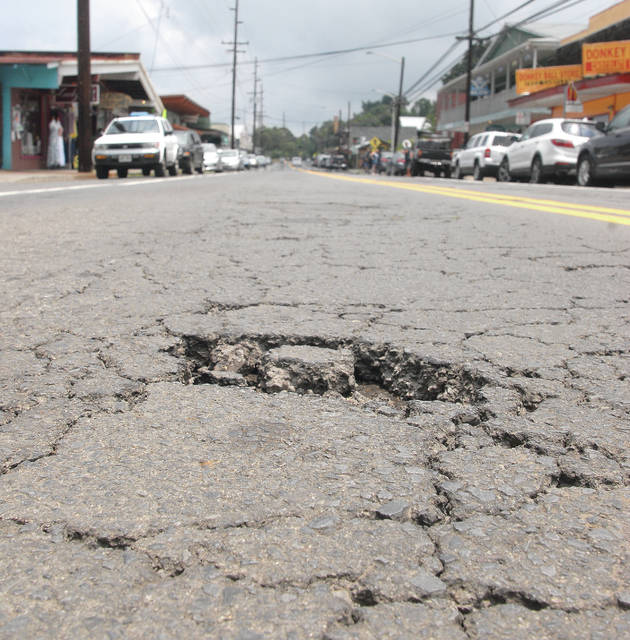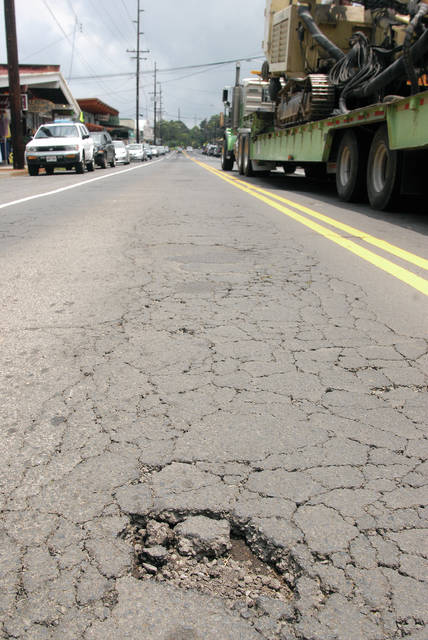KAINALIU — On a given day, more than 16,000 cars come along this road, bringing travelers along Mamalahoa Highway as it winds its way along the slopes of Hualalai through towns like Kainaliu, passing by historic buildings through Kona’s coffeelands.
KAINALIU — On a given day, more than 16,000 cars come along this road, bringing travelers along Mamalahoa Highway as it winds its way along the slopes of Hualalai through towns like Kainaliu, passing by historic buildings through Kona’s coffeelands.
But the road here — specifically the mile-long stretch that runs directly through Kainaliu — also takes cars over cracked and rutted pavement. It’s one of just 4 miles of West Hawaii pavement included in a batch of state Department of Transportation data the agency has said is in poor shape.
“Worse than poor,” said one person walking through town on Wednesday.
The report is part of a batch of data released by the Department of Transportation that evaluated conditions of state roads throughout Hawaii, looking at smoothness, cracking and rutting.
The batch of road data included Routes 11 and 19, which together circle much of the island, as well as smaller roads, such as Kealakehe Parkway and Keahole Airport Road.
Of the more than 180 miles of West Hawaii pavement, only a total of 4 miles of pavement are considered in “poor” shape, including the mile stretch that runs through Kainaliu. The rest of the region’s roads evaluated were either scored as “fair,” 126 miles, or “good,” 57.5 miles.
The other 3 miles scored as “poor” are all along Route 250, also known as Kohala Mountain Road, which runs south from Hawi.
But while the vast majority of that 19-mile road sees fewer than an average 2,400 vehicles per day, the road through Kainaliu recorded more than six times that, according to DOT data. The Department of Transportation did not respond to questions posed earlier this week by Saturday evening.
While Route 11 is a state road, the mile the DOT rated “poor” is actually part of a longer segment officially under the jurisdiction of Hawaii County.
From May 2006-October 2007, the county contracted with a construction group to do roadway improvements and resurfacing work along the county’s segment from Honalo to Captain Cook, said Barett Otani, spokesman for the county Department of Public Works.
Otani said the department has plans to take up resurfacing efforts on a quarter-mile length of the road south of the area, closer to the Captain Cook fire station, but is also looking for opportunities to improve the road in other parts of the area.
“Assessments are being made to prioritize other areas from Honalo to Captain Cook,” Otani said, “and as funding becomes available, we will be able to proceed with repairs on sections along this well-traveled corridor.”
But several people in the area on Wednesday rated the road through town as better than average and said there are other roads that need more immediate attention.
“Irrespective of the surface condition of the road in this particular stretch right here, it’s inherently better in many ways than either end of it,” said Heath Hanson, “because people have to slow down through here — at least they’re supposed to slow down through here.”
Kealakekua Bay resident Shelley Fedunew said judging road standards depends on what it’s being compared to.
“Like, I work in third world countries. This road is state-of-the-art,” she said. “You come from California, they’re not going to like it so much.
“It’s all in perspective, right?” she added.
Fedunew said compared to other roads she uses in the area, she would rate the road through the area as “probably a 6 or 7.”
“There’s room for improvement,” she said, “but I don’t think it’s an emergency.”
Jim Medeiros, who worked in road construction and repair for 15 years, said in his opinion there are several factors at work, including overweight vehicles being allowed on the roads, which can crack the road and lead to sinkage.
At the same time, Medeiros acknowledged that part of the issue could be related to how the road was built decades ago, which can’t be blamed on the state or any contractor.
The existing roads are often built on top of older roads, which themselves might have originally just been built up with big rocks.
As vehicles pass over that original base layer, the rumbling can cause those base rocks to move, slip or deteriorate, causing voids between the rocks to grow or shift over time.
“It’s just jiggling all of this surface, this base under here” he said, “so if there’s voids, obviously with this stretch being used so much, the voids are showing up more than ever because of heavy use.”
Those voids aren’t really anyone’s fault, he said, but a natural result of heavy use.
“If that’s what it is — it’s just sinking from the old road below having voids that keep on going down there — let’s be real about the fact that it is happening and address these voids over and over,” he said. “Not just say ‘OK we did it, so you ain’t getting nothing in this area for at least 20 years.’ That’s what I feel like.”
But the steps that can be taken to fix the roads require money, he said, and officials ought to work to get funds.
“Be proactive in finding the funds,” he said. “It’s going to take funds, nothing more than funds to address this.”
Otani said resurfacing the road in Kainaliu has its own set of hurdles to overcome.
Areas like Kainaliu, he said have a narrow roadway with individual access to local businesses. Efforts to reconstruct the road, he said, would require lane closures and heavy machinery that could have a big effect on those businesses and also impact commuting times. Work plans would also need to address on-street parking, he said, as well as school and peak hour traffic.
And the road through Kainaliu isn’t the only one — or even the worst one — that needs addressing.
Hanson, who lives in Opihihale, just south of Kona Paradise, said the road farther south is “beyond poor,” adding that he regularly sees an overturned car on the side of the road.
The Department of Transportation rated pavement conditions in that area “fair” overall.
But Hanson said other conditions in the area make it a precarious drive, pointing to a lack of reflectors, street lights and lines marking the outer side of the road.
Hanson said a poor evaluation of pavement conditions on top of that is “insult to injury.”
“There’s already so many inadequacies about the road,” he said. “And so then to throw a poor pavement surface on top of that — and we get these flash floods and the drainage — so I mean, it’s just death by a thousand cuts.”
Fedunew said Puuhonua Road, which runs from Kealakekua Bay and becomes Keala O Keawe Road on its way to Honaunau, is one she believes needs better maintenance.
“That road is very dangerous, especially the way people drive on it,” she said.
Drivers often speed down that road in spite of pedestrians, cyclists and runners that also use it.
“I would think that road would need attention far more than this does,” she said, calling the road through Kainaliu “the least of their concerns.”
Most of Puuhonua Road/Keala O Keawe Road is also a county road. Otani said the county is evaluating the area and said the department could resurface and widen the roadway as funds become available.
The county’s Highways Division will be resurfacing Lunapule Road and Kealakaa Street. Work is scheduled for the first quarter of next year.


